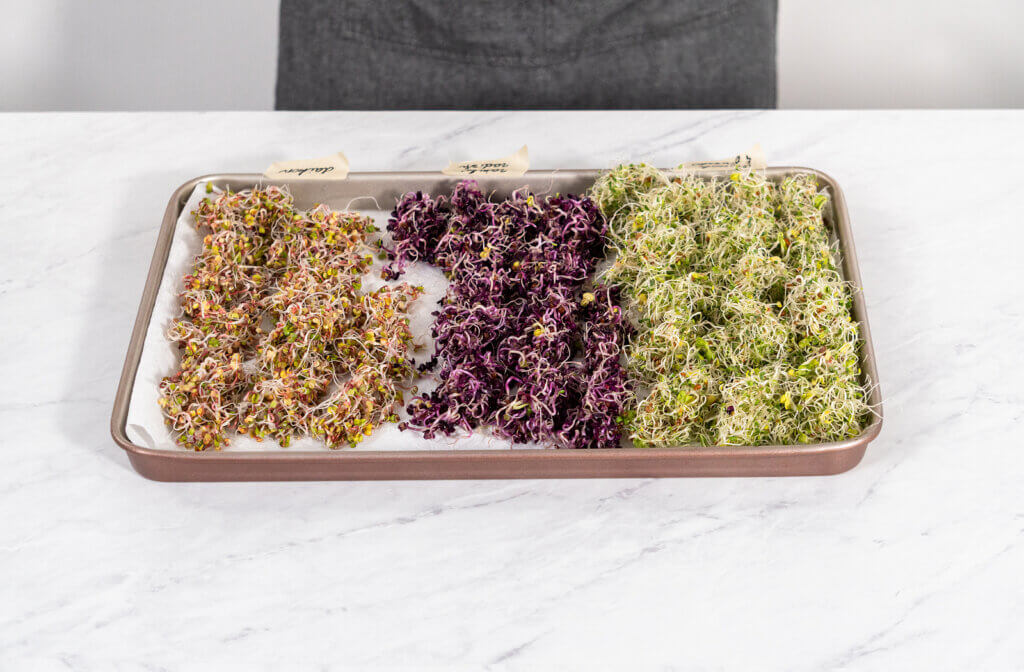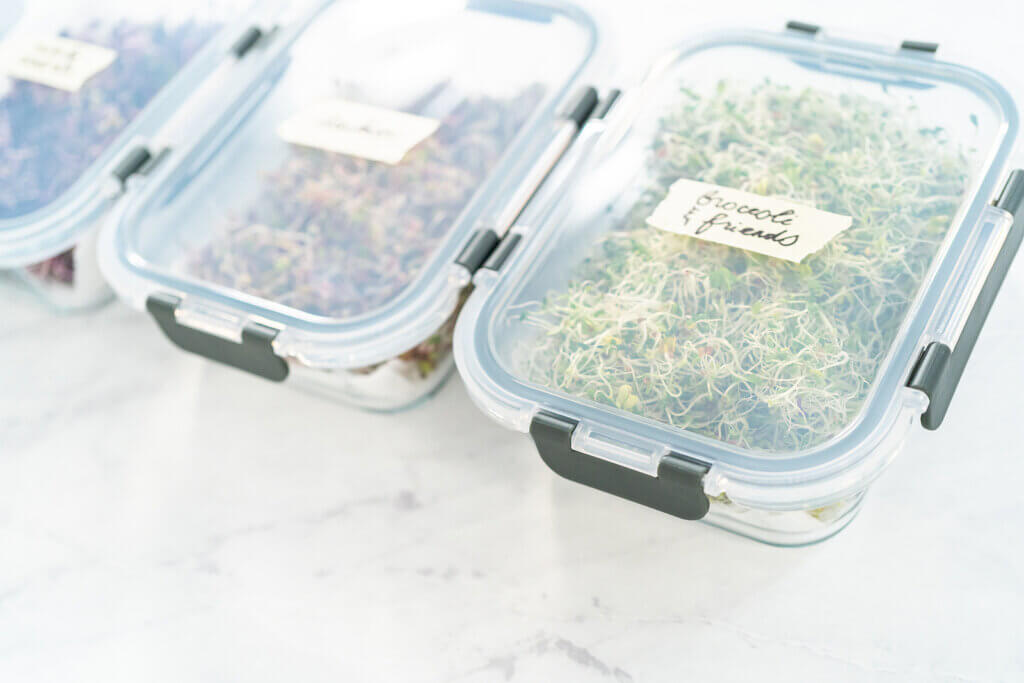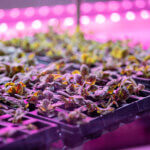Table of Contents
Grow Microgreens on Paper Towel
Growing microgreens at home has been an incredibly rewarding experience for me, and I'm excited to share how you too can cultivate these vibrant, nutrient-rich greens with ease. Picture this: you're in your kitchen, and right there, on your countertop, is a lush spread of microgreens sprouting from nothing more than a simple paper towel.
That's right, no need for fancy equipment or a green thumb! I was amazed to discover that these tiny greens, which pack a serious punch in both flavor and health benefits, could be grown so effortlessly. In my journey, I've learned a lot about choosing the best seeds, nurturing these delicate plants, and knowing exactly when to harvest them for maximum taste and nutrition.
It's not just a step towards enhancing your meals; it's about embracing a sustainable lifestyle and contributing to our planet's well-being. Let me guide you through each step of this fulfilling indoor gardening adventure, and together, let's bring a burst of greenery and goodness into our homes.
Choosing the Right Seeds for Microgreens
Embarking on the journey to cultivate microgreens on paper towels begins with the crucial step of selecting the right seeds. Microgreens, the young seedlings of edible vegetables and herbs, can be grown from a diverse range of plant species, each contributing a distinct flavor and nutritional profile to your culinary creations.
Understanding the nuances of each variety is key to enhancing your dishes with these flavorful and nutritious greens. Here's an expanded look at some popular microgreen varieties and the unique aspects to consider when choosing seeds for your indoor garden:
- Basil Microgreens: Known for their aromatic, intense flavor, basil microgreens add a fresh, herbal touch to salads, pasta dishes, and even cocktails. Ideal for those looking to infuse a classic Italian flair into their cooking.
- Radish Microgreens: These microgreens bring a peppery, slightly spicy kick, making them perfect for adding a punch of flavor to sandwiches, wraps, and salads. Their vibrant color also adds an aesthetic appeal to dishes.
- Sunflower Microgreens: With their mild, nutty flavor and satisfying crunch, sunflower microgreens are a versatile choice for a variety of dishes, from salads to sandwiches, and even as a healthy snack on their own.
- Pea Shoots: Known for their sweet and tender profile, pea shoots are excellent for garnishing and adding a touch of sweetness to salads, stir-fries, and pasta dishes.
- Arugula Microgreens: These microgreens offer a spicy, peppery taste, making them a great choice for those who enjoy a bit of heat in their meals. They work well in salads, as pizza toppings, or in sandwiches for an extra zing.
- Cilantro Microgreens: With a fresh, citrusy flavor, cilantro microgreens are an excellent addition to Mexican and Asian cuisine, enhancing tacos, curries, and noodle dishes with their distinctive taste.
- Kale Microgreens: A nutrient-dense option, kale microgreens bring a mild, earthy taste to dishes. They're great in smoothies, salads, and as a nutritious topping for soups and stews.
- Mizuna Microgreens: Offering a mild, mustard-like flavor, mizuna microgreens are ideal for those who enjoy a subtle hint of spice. They can be used in salads, sandwiches, and as a garnish for Asian dishes.
- Chard Microgreens: These colorful and nutritious microgreens have a slightly earthy taste and add a pop of color to any dish. They're excellent in salads, as a topping for pizzas, and in grain bowls.
- Beet Greens Microgreens: With their mildly sweet flavor and vibrant red or green leaves, beet greens microgreens are not only visually striking but also add a unique taste to salads, and smoothies, and as a garnish for savory dishes.

Benefits of Growing Microgreens on Paper Towel
Delving into the practice of cultivating microgreens on paper towels unveils a plethora of advantages, making this method not only innovative but also highly beneficial for gardeners of all levels. Let's broaden our understanding of these benefits:
Enhanced Accessibility: An Economically Sound Option
The use of paper towels as a growing medium stands out for its accessibility. Being a common household item, paper towels are readily available, negating the necessity for specialized gardening substrates or equipment. This ease of availability positions it as an economical and practical choice, particularly appealing to beginners or those looking to experiment with microgreens without significant upfront investment.
Optimal Space Efficiency: Tailored for Compact Living
Growing microgreens on paper towels is a boon for space-constrained environments. Whether you're an apartment dweller, have limited outdoor space, or are a part of the urban gardening community, this method efficiently utilizes small areas. The compact nature of paper towels allows for setting up microgreen gardens in tiny spaces, on windowsills, or even on kitchen counters, making it a versatile option for urban gardeners.
Minimized Contamination Risk: A Cleaner Cultivation Approach
One of the standout benefits of using paper towels is the significant reduction in the risk of soil-borne diseases and pests. Unlike traditional soil-based methods, paper towels provide a sterile environment, drastically decreasing the likelihood of contamination. This hygienic approach leads to healthier growth and less maintenance in safeguarding your microgreens against common garden ailments.
Accelerated Germination: A Swift Path to Harvest
The excellent moisture retention properties of paper towels facilitate quicker germination and growth rates for microgreens. This characteristic is particularly advantageous for those seeking rapid results, enabling gardeners to enjoy their homegrown greens in a shorter timeframe compared to some soil-based methods.
Effortless Monitoring and Maintenance: Keeping a Close Eye
The transparency and simplicity of the paper towel method make monitoring the growth and health of microgreens a straightforward task. This ease of observation allows for early detection of any potential issues, ensuring that immediate actions can be taken to rectify them. Gardeners can thus maintain optimal growth conditions with minimal hassle, making it an ideal method for both novice and experienced gardeners.
See also our post on Daikon Microgreens
Materials You'll Need to Grow Microgreens on Paper Towel
To embark on the rewarding journey of growing microgreens on paper towels, you'll need a set of specific materials that will ensure the success and vitality of your miniature greens. Here's a detailed guide to the essential items and their roles in this process:
- Paper Towels: The foundation of your microgreens garden, these paper towels should be absorbent and free from chemicals or fragrances. Opt for a brand that offers strength and durability, as this will support the seedlings as they grow.
- Microgreen Seeds: Choose from a variety of seeds such as arugula, basil, radish, and mustard, each offering unique flavors and nutritional benefits. It's important to source your seeds from a reputable supplier to ensure high germination rates and healthy growth.
- Shallow Tray or Container: This will act as the base for your growing setup. Ensure that the tray is shallow enough to not drown the roots but deep enough to support growth. Consider trays that are easy to clean and reuse for future batches.
- Water Spray Bottle: A crucial tool for gently watering your microgreens. The misting action provides the right amount of moisture without disturbing the delicate seeds or seedlings.
- Transparent Plastic Wrap: This creates a greenhouse-like environment, which is vital for germination. The wrap helps in retaining moisture and warmth, thereby speeding up the germination process.
- A Second Spray Bottle: Having a separate bottle for misting during the growth phase is recommended. This ensures that the microgreens receive a consistent level of humidity, which is key to their development.
- Light Source: Microgreens need light to photosynthesize and grow. If natural sunlight is limited, consider using grow lights. These lights provide the spectrum of light needed for healthy growth and can be adjusted as per the growth stage of the microgreens.
- Labels and Markers: Labeling your trays with the type of microgreen and the date of planting is essential for tracking their growth and harvest times. This is especially useful if you are growing multiple varieties at once.

Step-by-Step Guide to Growing Microgreens on Paper Towel
Embarking on the journey of growing microgreens on paper towels is an exciting and rewarding process. This detailed guide will take you through each step, ensuring that even beginners can successfully cultivate these nutritious greens at home.
Step 1: Workspace Preparation
Creating an Ideal Environment: The first step involves setting up the right environment for your microgreens. Choose a spot in your home that is clean, has good air circulation, and is free from drafts and extreme temperature changes. Microgreens are delicate and need a stable, controlled environment to thrive.
Step 2: Seed Selection and Soaking
Choosing the Right Seeds: Begin by researching and selecting microgreen seeds that cater to your taste and health preferences. Consider factors like flavor, growth time, and nutritional value. Once chosen, soak your seeds in water in a small container. This soaking time varies depending on the seed type (usually between 4-8 hours), so refer to specific instructions for each seed variety.
Step 3: Paper Towel Preparation
Setting the Stage: Line your chosen shallow tray or container with several layers of quality paper towels. These towels should be moistened evenly to create an optimal germinating bed for your seeds. The moisture level is key – too much water can lead to mold, while too little might hinder germination.
Step 4: Sowing Seeds
Planting Your Seeds: Spread the pre-soaked seeds evenly across the moist paper towels, ensuring they have good contact. This is a crucial step as it directly influences the germination rate and overall yield of your microgreens.
Step 5: Creating a Mini-Greenhouse
Encouraging Germination: Cover your tray with transparent plastic wrap. This simulates a greenhouse environment, maintaining adequate humidity and warmth essential for seed germination. Monitor the moisture level under the plastic wrap to prevent mold growth.
Step 6: The Germination Process
Germination and Initial Growth: Place your setup in a well-lit area, preferably near a natural light source or under grow lights. Maintain a consistent temperature around 70-75°F (21-24°C). Regular misting is crucial during this stage to keep the environment moist. This phase typically lasts 3-7 days, depending on the seed type.
Step 7: Growth Monitoring
Watching Your Microgreens Grow: Once you see sprouts, remove the plastic wrap to increase air flow. Continue to mist the microgreens to maintain moisture. This is an exciting phase as you'll witness the rapid growth of your greens. Observe their color, height, and health to ensure they are developing properly.
Step 8: Harvest Time
Reaping the Fruits of Your Labor: After about 7-14 days, your microgreens should be ready to harvest. The ideal height for harvesting is about 1-3 inches. Use a clean, sharp scissor to cut the microgreens just above the paper towel level. Rinse them gently to remove any paper towel fibers or debris. Your fresh, home-grown microgreens are now ready to be enjoyed in salads, sandwiches, or as garnishes, offering a burst of flavor and nutrition.
By following these detailed steps, you'll be able to cultivate a continuous supply of fresh microgreens right in your kitchen, adding a homegrown touch to your meals.
Frequently Asked Questions (FAQs) – Growing Microgreens on Paper Towels
Q1: Is growing microgreens on paper towels really effective?
A1: Yes, it can be a simple and effective method for growing microgreens. While it may not be as conventional as soil or hydroponics, it offers several benefits, including affordability, space efficiency, and reduced risk of contamination.
Q2: Can I use any type of paper towel for this method?
A2: In theory, you can use most paper towels for growing microgreens, but it's best to choose high-quality, untreated paper towels without any added chemicals or fragrances. The better the paper towel's quality, the better the results you'll likely achieve.
Q3: How long does it take to grow microgreens on paper towels?
A3: The time it takes for microgreens to grow on paper towels varies depending on the variety and growing conditions. In general, you can expect to harvest your microgreens in about 7-14 days from sowing the seeds.
Q4: Can I reuse the paper towels for multiple crops?
A4: Reusing paper towels for multiple crops is not recommended. After one use, the paper towels may become contaminated or break down, reducing their effectiveness as a growing medium. It's best to start with fresh paper towels for each crop.
Q5: Do I need special lighting for growing microgreens on paper towels?
A5: While natural sunlight is ideal, especially for cost savings, you can also use grow lights. Microgreens require adequate light for healthy growth, so ensure they receive 12-16 hours of light daily.
Q6: Are there any specific tips for preventing mold or fungal issues?
A6: To prevent mold or fungal issues, ensure proper air circulation by removing the plastic wrap once your microgreens start sprouting. Also, avoid overwatering and maintain cleanliness in your growing area to minimize the risk of contamination.
Q7: Can I grow all types of microgreens on paper towels?
A7: You can grow many types of microgreens on paper towels, but some may be more suitable than others due to their growth characteristics. Experiment with different varieties to find which ones thrive using this method.
Q8: Do I need to fertilize microgreens grown on paper towels?
A8: Microgreens typically don't require fertilization when grown on paper towels. The seeds contain enough nutrients to support initial growth. However, if you notice slow growth or yellowing leaves, you can dilute a mild, balanced liquid fertilizer and use it sparingly.
Q9: Can I transplant microgreens grown on paper towels into soil later?
A9: While it's possible to transplant microgreens from paper towels into soil, it can be challenging, and some damage to the delicate roots may occur. It's generally easier to harvest and consume microgreens directly from the paper towels.
Q10: Are there any specific advantages to growing microgreens on paper towels over other methods?
A10: Growing microgreens on paper towels offers advantages like accessibility, space efficiency, and reduced contamination risk. However, the choice of method ultimately depends on your preferences and available resources.
Conclusion
In conclusion, my journey into the world of growing microgreens on paper towels has been nothing short of remarkable. This simple, cost-effective method has not only brought a new zest to my culinary endeavors but also introduced a touch of greenery into my living space, making it feel more vibrant and alive. The process, from selecting the right seeds to watching these tiny greens sprout and flourish on nothing more than a kitchen staple, has been deeply gratifying.
What truly stands out for me is the accessibility of this method. It's perfect for anyone, regardless of their gardening experience or living situation. Whether you're in a cramped city apartment or have a spacious home, growing microgreens on paper towels is feasible and fulfilling. The joy of harvesting your own fresh, nutritious microgreens, knowing they've been grown in the cleanest and most sustainable way possible, is incomparable.
Moreover, this experience has taught me a great deal about patience, care, and the importance of being in tune with the natural growth process. Each step, from germination to harvesting, has been a learning curve, enhancing my appreciation for the wonders of nature and the simplicity of creating something beautiful and beneficial from the most basic materials.
So, to anyone considering this venture, I say go for it! You'll be amazed at how something so small can add so much to your life, both in terms of health and happiness. Growing microgreens on paper towels is not just about gardening; it's a journey towards a more sustainable, self-sufficient, and mindful way of living.
Sources
https://extension.psu.edu/a-step-by-step-guide-for-growing-microgreens-at-home




Comments
Loading…